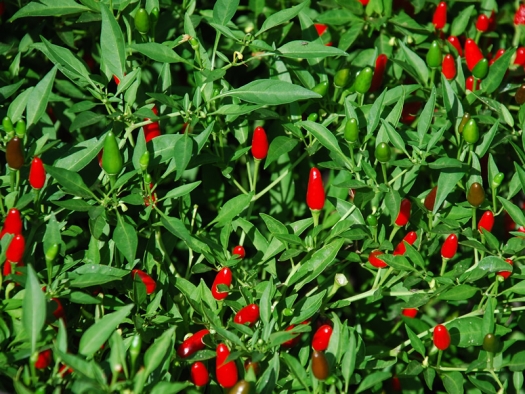Ed Wendlocher, founder and president of the Arthritis Help Centers, Inc., suffered from arthritis for many years until he discovered his sensitivity to various foods. He promoted clinical studies that resulted in several booklets, the latest being “Pain Foods!” After careful studies over many years it was learned that many taste enhancers, such as capsaicinoids, were exempted by the food labeling act and were also found in small quantities in many ordinary foods. These, it was discovered, caused many people, including Ed Wendlocher himself, to suffer from the classical phenomena of “arthritis.”
Now the mechanism is revealed through further academic research that capsaicinoids do, indeed, play a serious role in creating inflammation, tissue damage and “arthritis.”
Hot Chili Peppers
By Professor Jack Abel, Ph.D.
“Harvard Medical School researchers have now found that the receptor activated by chemicals in hot chili peppers is also responsible for the ongoing, burning pain associated with inflammation, tissue damage and arthritis.”1
The chemicals in the hot chili peppers that cause them to be hot are the capsaicinoids. Capsaicinoids are strong irritants that act directly on the pain receptors in your skin and mucous membranes. The strongest capsaicinoids are capsaicin and dihydrocapsaicin. Capsaicin is so strong that a single drop diluted in one million drops of water will still warm your tongue. Like dihydrocapsaicm, it delivers a sting all over your mouth. A third capsaicinoid, nordihydrocapsaicin, produces a warmer, mellower sensation in the front of your mouth and palate. A fourth, homodihydrocapsaicin, packs a delayed punch, delivering a stinging, numbing burn to the back of your throat.
Until now, capsaicin has been reported to primarily have beneficial effects on the body. It is best known as an effective pain relief substance when applied topically to the skin where it destroys certain nerve cells and prevents pain signals from reaching the brain. However, increased research of capsaicin is now uncovering that it also has significant detrimental effects on the body.
Capsaicin is now confirmed to be a primary cause of the on-going, burning pain associated with inflammation, tissue damage and arthritis. Capsaicin is a strong irritant. Applied to the skin, it causes the small blood vessels under the skin to dilate; increasing the flow of blood to the area and making the skin feel warm. It stimulates nerve endings in your mouth normally stimulated by a rising body temperature, sending impulses to your brain that release endorphins giving you a false sense of well-being. Eating hot chili peppers may upset your stomach, irritate the lining of your stomach, irritate your bladder so that you have to urinate more frequently or even make your urination painful.
The hot chili pepper plants are cousins of tobacco [and tomatoes] being in the same Solanaceae plant family. The hot chili peppers contain many of the same natural toxins as tobacco. By comparing the established LD-50 values (measures of toxicity), we see that the capsaicin in hot chili peppers is in the same league as a dangerous toxin as is nicotine in cigarette smoke.
Capsaicin is now used commercially as a pesticide on fruits and vegetables as it both kills insects and repels animals from crops. Again, based on LD-50 values, it is one of the more dangerous toxic pesticides in use today.
Hot chili pepper, also known as cayenne pepper, is made from the seeds and pods of Capsicum peppers, a species completely different from Piper nigrum, the plant whose fruit is used as black pepper (the one in the shaker on your table). The Capsicum peppers are native to Mexico, Central America, the West Indies and much of South America, and similar varieties are also native to the Far East. They may be long and thin like the cayenne pepper, large and firm like the Anaheim, cone shaped like the jalapeno or small and cherry shaped. Tabasco peppers, used to make a popular hot sauce, are a variety of hot peppers known as Capsicum frutescens. Ground red pepper labeled cayenne pepper or simply red pepper is made by grinding the smaller, more pungent Capsicums. The term “red pepper” may also be used to describe ground red pepper milder than, cayenne. Crushed red pepper, the spice you find in pizza parlors, is made from the seeds of the hot varieties of Capsicum annuum and Capsicum frutescens. Chili powder is a blend of red pepper with other herbs and spices.
Recent studies completed in association with scientists at a major university show that persons with arthritis can significantly reduce their pain, swelling and stiffness by conscientiously avoiding the foods containing the hot chili peppers and certain other food ingredients.
The problem: hot chili ingredients are not easy to avoid as they are rarely shown on the food label by that name. They are usually shown on the label as spices, spice extracts, flavorings, natural flavorings or seasonings; or added as colorings or preservatives and not shown at all.
What Harvard Medical School researchers seem to have concluded is as follows:
- When chili peppers activate certain nerve receptors, this activation is also responsible for a burning sensation associated with inflammation, tissue damage and “arthritis.”
- When inflammation occurs, a “p38” molecule switches on. This is an intracellular signaling molecule which causes a “cascade” of enzymes to increase the amount of heat that passes through a protein known as “TRPV 1,” sometimes called the “ion-channel protein.” It is also sometimes called the “chili pepper receptor.”
- The “chili pepper receptor” is very sensitive to capsaicin. Capsaicin causes chili peppers to feel “hot.”
- Regulation of the chili pepper receptor was not expected, according to Harvard anesthesia researcher professor Clifford Woolf, as large increases in the amount of receptor from increasing inflammation does not change production of mRNA. However, “The gene itself is not being changed, the mRNA that is being translated is.”
- Woolf may perform further research in using p38 inhibitors for treatment of inflammation and accompanying pain.
Footnotes
- Cohen, Hal. “Hot research, burning pain: the protein TRPV1 is sensitive to capsaicin, found in chili peppers.” Frontlines, The Scientist, Oct. 14, 2002, v16 i20 p8(1).
The Rheumatoid Disease Foundation / The Arthritis Trust of America was dissolved in 2020 and all website content was transferred to the Foundation for Alternative and Integrative Medicine.



